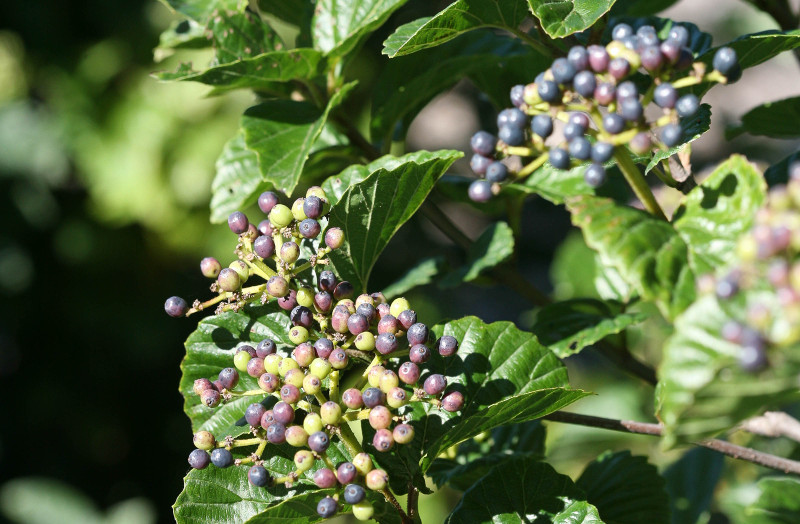Viburnum shrubs are one of the most popular native plants grown in the United States. The flowering shrubs can be evergreen, semi-evergreen and deciduous. Most types are deciduous, meaning the leaves drop each winter. Not to worry, the plants still provide 4 seasons of interest because most will self pollinate and produce berries that last through the winter and really stand out!
The foliage can also be attractive, with shiny green or dark green leaves to contrast with the white flowers in the summer. Or leaves that turn red in the fall. This plant truly provides interest in spring, summer, fall and winter!

The berries come in all different types of colors including red, which is the most common, but will also come in blue, blue-black, and pink. The fruit attracts birds and other wildlife, especially during winter when food sources are limited for wildlife.

The flowers will be white most of the time, but some varieties will have pink or yellow shades as well. The bloom time is typically from late spring to early summer, depending on the variety and where you live.

Here are some general guidelines to successfully care for your viburnum shrubs. Click on each link for more in-depth information in each topic.
Growing Viburnum
Because viburnum are native, the care for these shrubs is minimal. Choose a location that has well drained soil and gets partial shade to full sun (so at least 6 hours of direct sunlight). The plants will need some help to get established the first year, but once the plants are established, they will flourish without much work at all!
Planting Viburnum
The soil needs to drain well, but viburnum can handle a wide range of soil quality.
Be sure to use correct spacing between plants, depending on the variety you have. This will allow the root ball to have enough room to grow once the plants reach mature size. It also allows for proper air circulation and sunlight to hit the plants.

Watering Viburnum
Provide water once per week to help get the plants established during the first year. Once the plants are established, they are very drought tolerant and won't need supplemental water other than rain water besides during periods of extreme drought. Do not over-water the plants and allow for the soil to dry out completely between each watering. That is why having well drained soil is so important, so the roots don't get root rot.
Fertilizing Viburnum
You can apply a slow release fertilizer once a year made for shrubs and trees. Use according to directions on the label. Because the plants are native, this isn't necessary. If you choose to fertilize, do so in the early spring as new leaf growth starts to emerge.
Pruning Viburnum
These flowering shrubs can be pruned or trimmed at any time through the year. But typically the best times are late winter or early spring. Pruning can help control the size of the bushes to the desired size, help the plant grow more blooms and have healthier branching, or it can help remove leggy branches. Feel free to trim off and remove dead or sick branches and leaves at any time throughout the year. That will help air circulation and promote new healthy growth in the plant.

Viburnum Winter Care
Viburnum can be winter hardy from USDA zones 3 - 10 depending on the type you have. The bushes provide fall color with the foliage turning shades of red and yellow. In winter is when the berries really stand out!
Growing Viburnum in Pots
Container grown viburnum is a great way to grow these shrubs if you don't have enough space in your yard! Follow the same care steps to grow in containers. You may need to provide additional water and fertilizer if you choose to grow in planters or other containers. In the winter, make sure the plants are protected in colder areas of the country, like zones 3, 4 and 5.

Common Viburnum Questions
If you have questions on viburnum, please feel free to email us and we will get back to you as soon as possible. Who knows, your question may end up on this page, because you probably aren't the only person with the question!
Are Viburnum Berries Edible?
Most are edible and can be used in different ways.
Are Viburnum Deer Resistant?
Deer seldomly eat viburnum unless they are very hungry and there are no other sources of food around.
Are Viburnum Poisonous?
No, viburnum are not poisonous in most cases. Some varieties can be, so do your research before ingesting the berries or other parts of the plant. The berries are the only part of the plant we recommend consuming.
What Are Some Of The Most Well Known Types Of Viburnum?
Viburnum dentatum - arrowwood viburnum
Viburnum macrocephalum - Chinese snowball
Viburnum opulus - guelder rose
viburnum plicatum - Japanese snowball
viburnum davidii - evergreen variety
Viburnum carlesii - korean spice
viburnum suspensum - Sandankwa viburnum
Viburnum rhytidophyllum - leatherleaf viburnum
Viburnum odoratissimum - sweet viburnum
Can Viburnum Take Full Sun?
Generally speaking, viburnums will do well in full sun or partial shade, however for higher quality blooms, berries, and autumn color, the more sun the better!
Why Are My Viburnum Dying?
Viburnum can be a bit picky about its moisture situation. Their preference leans towards moist, but well-draining soils. They can tolerate periods of drought, but eventually, this can lead to wilting and leaf loss. Viburnum also does not like wet soil, which can lead to root rot, diseases, and pests.
What Is The Viburnum Height?
Viburnum comes in a large range of sizes. Some varieties of viburnum stay around the 3-foot tall mark and some can get as tall as 20 feet.
Is Viburnum Invasive?
Some viburnums, including Linden Viburnum, Japanese Snowball, and Siebold Viburnum, have been reported to be invasive in some areas of the United States.
What Is The Growth Rate For Viburnum?
Typically, viburnums can grow anywhere from 1 to sometimes even more than 2 feet, annually.
Why My Viburnum Leaves Turning Brown And Yellow?
Two issues relatively common to viburnum, which present with yellowing of leaves, are leaf spots and armillaria root rot (both of which are fungal diseases.) For leaf spot, surround the base of the plant with mulch to prevent water from splashing up on the leaves during watering, after you've removed and destroyed the affected leaves. Armillaria root rot can be controlled, but not cured, by pruning to increase air circulation, keeping the plant dry when possible, and keeping the base free of debris.
Have a question about Viburnum? Fill out the form below and we will try and get back to your question as soon as possible. We may even feature your question in this article to help other gardeners!
 |
Author Chris Link - Published 2-19-2021 |
